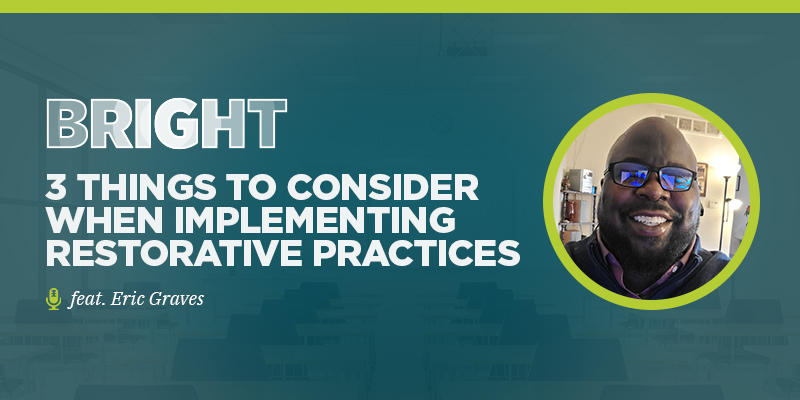Or listen on Apple, Spotify, Google, or another platform. Alternatively, you can read along with the transcript.
In this episode of the BRIGHT podcast, I chat with Eric Graves, the former statewide coordinator for the Michigan Cares program, who shares:
- Our collective perception of those who have wronged us,
- What community healing requires of all of us, and
- Three things to consider when implementing restorative practices.
You can listen to my conversation with Eric using the audio player above or by subscribing to the BRIGHT podcast in your app-of-choice (find us on Apple, Spotify, Google, and more) or by reading along with the transcript.
Of course, we understand that educators are busier than ever. If you don’t have time to listen to Eric’s full episode (which offers the fuller effect of his wisdom, energy, and examples), you can still benefit from a glimpse at his top three tips below.
3 things to consider when implementing restorative practices
#1. Garner a deep understanding of what restorative practices are not
There are many misconceptions about restorative practices. Before implementing this approach in your school community, it’s important to be well-versed in these nuances.
Restorative practices do not involve skipping over consequences. It’s not a permissive, do-whatever-you-want system.
Restorative practices are a paradigm shift in how we deal with people who commit infractions in our communities.
“People commit crimes for a good reason to them,” says Eric. “If I’m going to teach you something new, I can’t shame you. I have to help bring you back to this place where we restore you first, and then we can restore the community.”
Hurting people hurt people. Restorative practices offer those who commit crimes an opportunity to restore and heal, first themselves and then their community.
“If failure is not final, if people are allowed to make mistakes,” Eric says, “then we create an environment where we can renew.”
Ultimately, it’s an approach centered around keeping people in the community rather than pushing them away.
#2. Start getting community buy-in early
Community buy-in is super important when implementing restorative practices.
The first time a frustrated parent hears about restorative practices shouldn’t be a time when a student didn’t get expelled for behavior for which they historically would have been expelled.
Restorative practices are not a replacement for having appropriate protocols in place when a student’s behavior is genuinely dangerous to their peers.
Besides, if your new discipline system comes from a top-down mandate, people will naturally become resentful.
“A lot of people in schools adopt a program because they’ve been told to do so,” Eric adds. “Then, in their hearts and in their minds, they’re resentful.”
To gain community buy-in, you’ll need to have open conversations about restorative practices and informed empathy about why it is necessary.
#3. Build capacity with a comprehensive SEL curriculum
Once you have buy-in from your community, you can start working on building out the foundation for restorative practices.
That’s where having a comprehensive social emotional learning (SEL) curriculum comes into play.
According to CASEL, the five pillars of SEL are:
- Self-awareness
- Social awareness
- Self-management
- Responsible decision-making
- Relationship skills
These skills are critical both to preventing infractions from happening in the first place AND for helping all parties restore after a crime has been committed.
“If we don’t have a sense of who we are, if we don’t understand empathy, and if we don’t know how to move from the conditioning of our past,” says Eric, “then we can’t move into the future.“
Restorative practices aren’t easy. They ask us to reconcile some big feelings about those who have wronged us. This process can be emotionally difficult for all parties involved, even adults.
Having an SEL curriculum in place prepares school communities for the kind of emotional work required to engage with restorative practices.
If your school could benefit from a free social emotional learning curriculum, check out Michigan Cares, which is available to all Michigan schools or districts at no cost. There’s real-time data reporting for school leaders, mental health & prevention content, and an option to add on a restorative justice program.
My favorite quotes from this episode
“The purpose of discipline is to teach and not to punish.”
“We build a way of restoring the individual who committed the offense first. That’s a hard thing to grasp. But a person can’t restore something when they don’t fully understand it. You don’t want a superficial apology.”
“Before you can restore something, you have to come to an understanding of what the good reason was behind it. And they’re always good reasons. That’s hard to understand. They’re always good reasons to them. We have to ask: What was the good reason why you did what you did? And how did that work for you?”
“Sometimes we want to seek justice because we’ve been taught it will heal us. But we know that that’s not necessarily the truth.”
“It’s a new way of thinking. It really moves away from our whole process of how we right wrongs in our society. It’s not anti-consequences. It’s a new way of keeping people in the community and saying, ‘I’m not going to let you go.’”
“We know that the law is reactionary and that there will never be enough laws to respond to the things that we all will do. If we’re waiting for there to be enough violations to correct society, we’re in trouble. We’re going to need some different structures.”
“How do we restore an environment when someone has violated our sense of safety, violated our sense of dignity, and made us feel uncomfortable? That’s the conversation that we need to have.”
Related resources
- Explore: Michigan Cares
- Read: 4 ways that zero-tolerance policies affect Michigan students [with infographics]
- Read: Restorative justice 101 — A paradigm shift in education [with infographics]
- Learn and earn: Social Emotional Learning: Introduction to SEL

